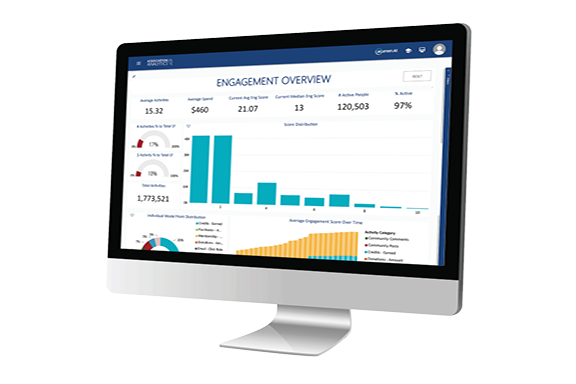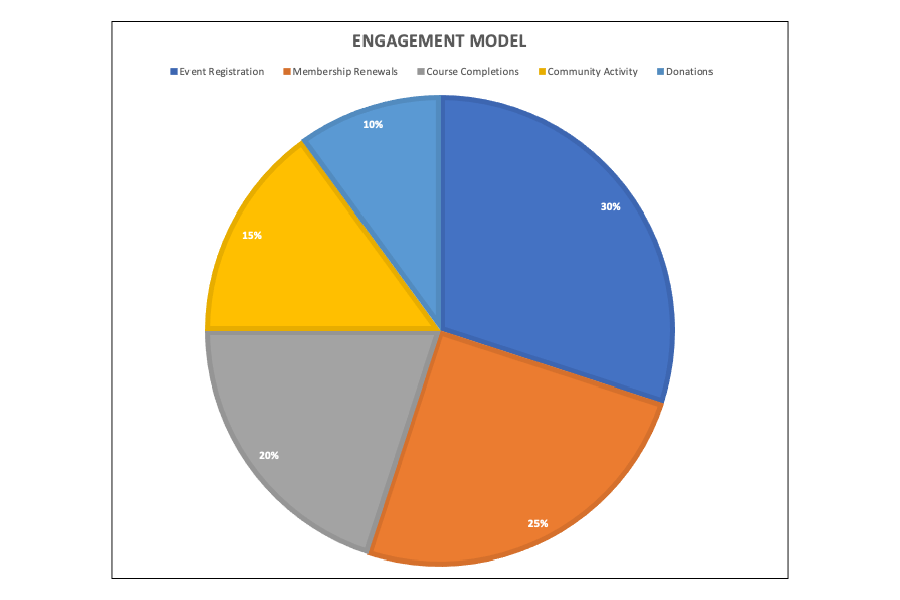Being in the association world, you’ve probably heard a lot about engagement scores. As data-loving professionals, our team gets many questions about what an engagement score is, how to assign members points and how to use the data. That’s why we’ve put together tips on getting started and provided a helpful free template and tutorial to help guide you.
As a refresher, let’s review the basic definition of engagement. Simply put – it’s an exchange of value. It is important because you want a relationship with your member where there is an even exchange of value. Members who are more engaged are more likely to take actions like renewing, spending more money, attending more meetings, and taking more courses. When you have a score for an individual member or a group of members, you can better engage them by reaching them with the right messaging at the right time.
There is a common misconception that an engagement score directly correlates to renewals. That is not quite the case. The engagement score is related to, but not equal to the probability that a member is going to renew. The engagement score is not the answer to one specific question. It is part of the answer to almost every question. It boils down to what questions you want the engagement score to answer. Consider questions with your business goals in mind.
Some example include:
- How do I get more members?
- How do I engage non-members?
- How do I get more people to take our courses?
- How do I get more members to attend our events?
- How do I increase non-dues revenue?
- Who is the most likely to speak at a conference?
- Are we doing better with connecting with members over time?
Building Your Engagement Score
Creating an engagement score may seem like a daunting task, but if you approach it with the right mindset and the right tools, you can get started quickly.
Engagements scores should start with a model using these 3 easy steps:
- Choose Activities
- Assign Weights
- Calculate Scores
Start with Model Building
A model is basically what you are going to count (activities) and how much you are going to count (weights). Start with a Modeling Workshop and invite subject matter experts from your organization who interact with your members (e.g. membership, philanthropy, finance, marketing, events)
- Brainstorm a list of activities you want to include in your engagement score.
- Once you have a complete list of activities, prioritize them based on your business goals.
- There is a good chance that you will come up with a very long list of activities. If this is the case, you should combine them into broader buckets with similar activities to get to a manageable number.
- Negotiate either by consensus or management direction to decide what activities to include in your scoring.
- Implement your engagement score model!
- Be flexible. Test things. If something doesn’t work, switch gears to another activity or business question to answer.
Step 1: Choose the Activities to Use in Your Model
Obviously, you can’t include every single activity. We recommend no less than 5 but no more than 10. You don’t want too many small sections. Generally, if you have more than 10 activities, they will be really small. The smaller ones can almost always be combined into a larger, more manageable number. Think back to your business goals and consider activities that drive:
- Operational outcomes – include activities that directly impact your revenue like renewals, purchases, meeting attendance, and course registration.
- Customer experience – think about the things that show you are providing a great member experience and improving your relationship with your members (Examples: survey responses, community engagement).
- Strategic objectives – these are often harder to measure. For example, if one of your goals is “to be a thought leader in your sector” you could look at content downloads, CE credits, traffic to the resources section of your website. These are things that show you are an industry leader.
Step 2: Assign Weights For a Meaningful Engagement Score
We advocate for normalizing your score with weights. Use 100 as a perfect score based on this model. Scoring is based on the activities you chose and the weights you assign them. Weight is the maximum score for each activity. For example, if you weight event attendance at 30. Someone who attends all events would get a 30 as opposed to someone who attends some events would get a 15.
- Your overall model must total 100. Members who achieve all points are pretty rare. So, you need to determine what your “good” score is.
- Engagement points for each section are based on comparison to the population. So it is relative to what everyone else in the population has done. With this in mind, look at activities that are broadly applicable to all members like event registrations, email clicks, and community activity. You wouldn’t want to use activities that are more narrow in scope like being a board member or an exclusive award winner.
Step 3: Calculate Your Scores, Don’t Assign Them
As you start scoring, you should include data that is easily accessible like the number of members, amount of donations and course registrations. Eventually, you can include data that is harder to access like social media interactions or vendor-managed data sources.
- Use data to calculate. Don’t assign scores. When weighting, avoid making up numbers for your activities. Instead, decide how important the activity is relative to everything else on a 100 point scale and then let the model calculate the points for the activity.
- We suggest using three years of data for relevancy. Using one year won’t give you enough information and ten years will give you too much (and it may no longer be relevant). Even using three years of data, you want to keep decay in mind. Certain activities diminish in importance over time. For example, if someone donated in 2020 and hasn’t since, that donation has decayed in importance.
Now you have engagement scoring! What do you do with it?
There are so many things you can do with your engagement scores that are valuable to your organization. Here are a few ideas:
Use individual engagement scores to find:
- Buyers
- Attendees
- Speakers
- Donors
- Award nominees
Use aggregate engagement scores to:
- Validate your value proposition
- Define personas – aggregate data and build a journey map by persona.
- Segment customers
- Optimize marketing campaigns to better target messages
Our recent blog, Use Engagement Scores to Point Your Members in the Right Direction reviews a lot more ways you can use your engagement scores. You can also chat with one of our data-loving experts to get the most out of your engagement score.
Bonus! A Free Tool for Beginners
Your success is our success.
- Here’s a template spreadsheet to help you get started with your engagement scoring
- This video clip features walks you through how to use the worksheet
- Check out our entire webinar on best practices for calculating your scores: Everything You Want to Know About Engagement Scoring (but didn’t know to ask)





